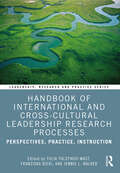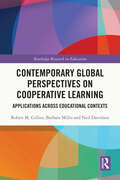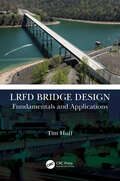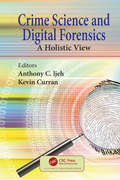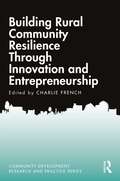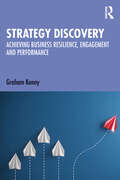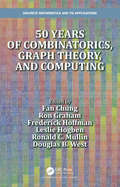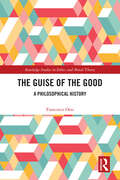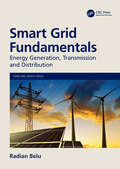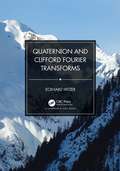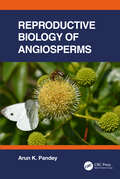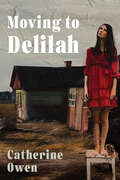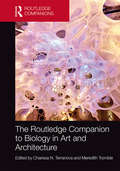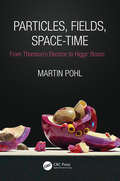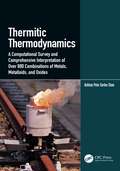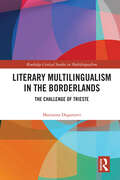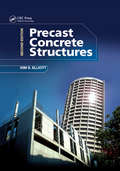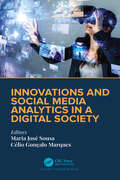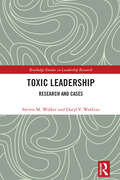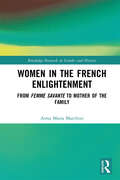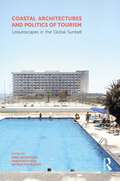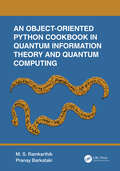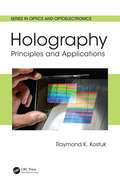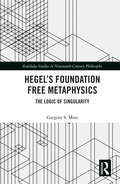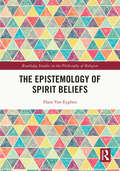- Table View
- List View
Handbook of International and Cross-Cultural Leadership Research Processes: Perspectives, Practice, Instruction (ISSN)
by Yulia Tolstikov-MastAn invaluable contribution to the area of leadership studies, the Handbook of International and Cross-Cultural Leadership Research Processes: Perspectives, Practice, Instruction brings together renowned authors with diverse cultural, academic, and practitioner backgrounds to provide a comprehensive overview and analysis of all stages of the research process.The handbook centers around authors’ international research reflections and experiences, with chapters that reflect and analyze various research experiences in order to help readers learn about the integrity of each stage of the international leadership research process with examples and discussions. Part I introduces philosophical traditions of the leadership field and discusses how established leadership and followership theories and approaches sometimes fail to capture leadership realities of different cultures and societies. Part II focuses on methodological challenges and opportunities. Scholars share insights on their research practices in different stages of international and cross-cultural studies. Part III is forward-looking in preparing readers to respond to complex realities of the leadership field: teaching, learning, publishing, and applying international and cross-cultural leadership research standards with integrity. The unifying thread amongst all the chapters is a shared intent to build knowledge of diverse and evolving leadership practices and phenomena across cultures and societies.The handbook is an excellent resource for a broad audience including scholars across disciplines and fields, such as psychology, management, history, cognitive science, economics, anthropology, sociology, and medicine, as well as educators, consultants, and graduate and doctoral students who are interested in understanding authentic leadership practices outside of the traditional Western paradigm.
Contemporary Global Perspectives on Cooperative Learning: Applications Across Educational Contexts (Routledge Research in Education)
by Robyn M. Gillies Barbara Millis Neil DavidsonThis volume captures contemporary global developments in cooperative learning (CL) across varied educational contexts, levels, and disciplines.Cooperative learning is widely recognized as a pedagogical practice that promotes socialization and learning among students, from kindergarten to tertiary education and across different subject domains. With chapters from contributors throughout the Global North and South, this comprehensive volume offers a wide-ranging perspective and addresses a range of cooperative learning pedagogies including relational, online, and peer learning, STAD, the Jigsaw model, and dialogic talk. The chapters draw on novel empirical research and theory to highlight best practices in cooperative learning, whilst also considering the challenges, limitations, and factors which drive or inhibit learner engagement and success. Consistent attention is given to the pivotal role of the educator in implementing cooperative learning to maximum benefit to enhance students’ affective, social, cognitive, and metacognitive learning.Thus, this book will appeal to scholars and researchers across a variety of subjects; and will provide an additional benefit to in-service and pre-service educators who already practice cooperative learning in their classrooms, as well as those who are interested in implementing the model.
LRFD Bridge Design: Fundamentals and Applications
by Tim HuffThis book examines and explains material from the 9th edition of the AASHTO LRFD Bridge Design Specifications, including deck and parapet design, load calculations, limit states and load combinations, concrete and steel I-girder design, bearing design, and more. With increased focus on earthquake resiliency, two separate chapters– one on conventional seismic design and the other on seismic isolation applied to bridges– will fully address this vital topic. The primary focus is on steel and concrete I-girder bridges, with regard to both superstructure and substructure design.Features: Includes several worked examples for a project bridge as well as actual bridges designed by the author Examines seismic design concepts and design details for bridges Presents the latest material based on the 9th edition of the LRFD Bridge Design Specifications Covers fatigue, strength, service, and extreme event limit states Includes numerous solved problems and exercises at the end of each chapter to illustrate the concepts presented LRFD Bridge Design: Fundamentals and Applications will serve as a useful text for graduate and upper-level undergraduate civil engineering students as well as practicing structural engineers.
Crime Science and Digital Forensics: A Holistic View
by Anthony C. IjehThis volume is a collation of articles on counter forensics practices and digital investigative methods from the perspective of crime science. The book also shares alternative dialogue on information security techniques used to protect data from unauthorised access and manipulation. Scandals such as those at OPCW and Gatwick Airport have reinforced the importance of crime science and the need to take proactive measures rather than a wait and see approach currently used by many organisations. This book proposes a new approach in dealing with cybercrime and unsociable behavior involving remote technologies using a combination of evidence-based disciplines in order to enhance cybersecurity and authorised controls. It starts by providing a rationale for combining selected disciplines to enhance cybersecurity by discussing relevant theories and highlighting the features that strengthen privacy when mixed. The essence of a holistic model is brought about by the challenge facing digital forensic professionals within environments where tested investigative practices are unable to provide satisfactory evidence and security. This book will be of interest to students, digital forensic and cyber security practitioners and policy makers. It marks a new route in the study of combined disciplines to tackle cybercrime using digital investigations and crime science.
Building Rural Community Resilience Through Innovation and Entrepreneurship (ISSN)
by Charlie FrenchDrawing from empirical analyses, case studies, and a synthesis of best practices, this book explores how innovation manifests itself in rural places and how it contributes to entrepreneurial development and resilience. Innovation in rural places may come about as a result of new forms of collaboration; policies that leverage rural assets and address critical service or product gaps; novel strategies for accessing financial capital; infusion of arts into aspects of community life; and cultivation of networks that bridge entrepreneurs, organizations, and institutions. The chapters illustrate how a number of innovation-related characteristics relate to economic vibrancy in rural places such as a strong connection to the arts, adaptive and sustainable use of natural resources, value-chain integrated food systems, robust bridging social capital networks, creative leveraging of technology, and presence of innovation-focused entrepreneurs. Through exploration of these and other topics, this book will provide insights and best practices for rural community and economic development scholars and practitioners seeking to strengthen the rural innovation ecosystem.
Strategy Discovery: Achieving Business Resilience, Engagement and Performance
by Graham KennyPersonal, useful, actionable and grounded in research, this book will shift your thinking from "strategy development" to "strategy discovery" to enable you to deal with today’s business challenges, engage your staff and boost your business performance. Management teams and boards are facing disruption on all sides, from morphing customer preferences to the COVID pandemic to climate change. At the same time they are floundering in strategy confusion with too many concepts and not enough clarity. In this book, strategy expert and regular Harvard Business Review author Graham Kenny releases managers and directors from their strategy haze. His simple and effective framework allows managers to navigate the current maze of ideas and approaches and maximize their competitive advantage. Kenny’s readable style is equally effective: each chapter begins with an engaging story, then builds on this with cases, client examples, sidebars and more, ending with a series of action points to provide a pathway to success. CEOs, senior-level and middle managers across all functions and sectors, including private, public and not-for-profit organizations, who discuss and set strategy for their organization or business unit will appreciate the articulated framework, illustrative anecdotes and positive encouragement this book offers.
50 years of Combinatorics, Graph Theory, and Computing (Discrete Mathematics and Its Applications)
by Fan Chung, Ron Graham, Frederick Hoffman, Leslie Hogben, Ronald C. Mullin and Douglas B. West50 Years of Combinatorics, Graph Theory, and Computing advances research in discrete mathematics by providing current research surveys, each written by experts in their subjects. The book also celebrates outstanding mathematics from 50 years at the Southeastern International Conference on Combinatorics, Graph Theory & Computing (SEICCGTC). The conference is noted for the dissemination and stimulation of research, while fostering collaborations among mathematical scientists at all stages of their careers. The authors of the chapters highlight open questions. The sections of the book include: Combinatorics; Graph Theory; Combinatorial Matrix Theory; Designs, Geometry, Packing and Covering. Readers will discover the breadth and depth of the presentations at the SEICCGTC, as well as current research in combinatorics, graph theory and computer science.Features: Commemorates 50 years of the Southeastern International Conference on Combinatorics, Graph Theory & Computing with research surveys Surveys highlight open questions to inspire further research Chapters are written by experts in their fields Extensive bibliographies are provided at the end of each chapter
The Guise of the Good: A Philosophical History (Routledge Studies in Ethics and Moral Theory)
by Francesco OrsiThis is the first book to trace the doctrine of the guise of the good throughout the history of Western philosophy. It offers a chronological narrative exploring how the doctrine was formulated, the arguments for and against it, and the broader role it played in the thought of different philosophers. In recent years there has been a rich debate about whether value judgment or value perception must form an essential part of mental states such as emotions and desires, and whether intentional actions must always be done for reasons that seem good to the agent. This has sparked new theoretical interest in the classical doctrine of the guise of the good: whenever we desire (to do) something, we see it under the guise of the good; that is, we conceive of what we desire as good, desirable, or justified by reasons, in some way or another. This book offers a systematic historical treatment of the guise of the good. The chapters span from Ancient and Medieval philosophy (Socrates, Plato, Aristotle, Augustine, and Aquinas), through the early modern period (Hobbes, Spinoza, Locke, Hume, and Kant) and up to Elizabeth Anscombe's rediscovery in the 20th century after a period of relative neglect. Together they demonstrate how history can offer potential new models of the guise of the good—or new arguments against it—as well as to give a sense of how the guise of the good can bear on other philosophical issues.The Guise of the Good: A Philosophical History is an excellent resource for scholars and students working on the history of ethics, philosophy of action, and practical reason.
Smart Grid Fundamentals: Energy Generation, Transmission and Distribution (Nano and Energy)
by Radian BeluThis textbook provides a comprehensive overview of smart grids, their role in the development of new electricity systems, as well as issues and problems related to smart grid evolution, operation, management, control, protection, entities and components.The book consists of eleven chapters, covering core topics such as energy, environmental issues, basic of power systems, introduction to renewable energy, distributed generation and energy storage, smart grid challenges, benefits and drivers, smart power transmission and distribution. It includes chapters focusing on smart grid communication, power flow analysis, smart grid design tools, energy management and microgrids. Each chapter ends with several practical and advanced problems that instilling critical thinking and applies to industrial applications.The book can be used as an introductory and basic textbook, reference and training resource by engineers, students, faculty and interested readers to gain the essential knowledge of the power and energy systems, smart grid fundamentals, concepts and features, as well as the main energy technologies, including how they work and operate, characteristics and how they are evaluated and selected for specific applications.
Quaternion and Clifford Fourier Transforms (Trends In Mathematics Ser.)
by Eckhard HitzerQuaternion and Clifford Fourier Transforms describes the development of quaternion and Clifford Fourier transforms in Clifford (geometric) algebra over the last 30 years. It is the first comprehensive, self-contained book covering this vibrant new area of pure and applied mathematics in depth.The book begins with a historic overview, followed by chapters on Clifford and quaternion algebra and geometric (vector) differential calculus (part of Clifford analysis). The core of the book consists of one chapter on quaternion Fourier transforms and one on Clifford Fourier transforms. These core chapters and their sections on more special topics are reasonably self-contained, so that readers already somewhat familiar with quaternions and Clifford algebra will hopefully be able to begin reading directly in the chapter and section of their particular interest, without frequently needing to skip back and forth. The topics covered are of fundamental interest to pure and applied mathematicians, physicists, and engineers (signal and color image processing, electrical engineering, computer science, computer graphics, artificial intelligence, geographic information science, aero-space engineering, navigation, etc.).Features Intuitive real geometric approach to higher-dimensional Fourier transformations A comprehensive reference, suitable for graduate students and researchers Includes detailed definitions, properties, and many full step-by-step proofs Many figures and tables, a comprehensive biography, and a detailed index make it easy to locate information
Reproductive Biology of Angiosperms
by Arun K. PandeyThis book is designed to introduce the basics of different aspects of the biology of reproduction in a concise and coherent manner. The book aims to equip students with the fundamentals of the biology of reproduction and also update them with the most recent advances in the field of reproduction. The book has been organized into 16 chapters that introduce and explain different aspects in a stimulating manner. Each chapter is supplemented with a summary and relevant illustrations. A glossary has been added to help the students to understand some important scientific terms.The book offers comprehensive coverage of the important topics including: Flower structure and development Development and structure of male and female gametophytes Pollination biology, fertilization and self-incompatibility Endosperm, embryo and polyembryony Apomixis and seed biology A separate topic on experimental plant reproductive biology (experimental embryology) has been provided, which includes basics of cell, tissue and organ culture, anther culture, pollen culture, flower, ovary, ovule culture, embryo culture, somatic embryogenesis, synthetic seeds, protoplast culture and other aspects of plant biotechnology. The book aims to cater to the needs of the advanced undergraduate and post-graduate students in Botany, Forestry, Agriculture and related fields.
Moving to Delilah
by Catherine OwenFrom award-winning poet Catherine Owen, a collection of poems about one woman's journey from BC to a new life in Alberta, where she buys an old house and creates a new meaning of home.In search of stability and rootedness, in 2018 Catherine Owen moved from coastal Vancouver to prairie Edmonton. There, she purchased a house built more than one hundred years earlier: a home named Delilah.Beginning from a space of grief that led to Owen's relocation, the poems in this collection inhabit the home, its present and its past. These poems share the stories of decades of renovations, the full lives of Delilah's previous inhabitants, and Owen's triumphs and failures in the ever-evolving garden. The poems ultimately whirl out in the concentric distances of the local neighbourhood and beyond -- though one house can make a home, home encompasses so much more than one house.In this exceptional and lyrical collection, Catherine Owen interrogates her need for economic itinerancy, traces the passage of time and the later phases of grief, and deepens her understanding of rootedness, both in place and in poetic forms.
The Routledge Companion to Biology in Art and Architecture
by Charissa N. Terranova Meredith TrombleThe Routledge Companion to Biology in Art and Architecture collects thirty essays from a transdisciplinary array of experts on biology in art and architecture. The book presents a diversity of hybrid art-and-science thinking, revealing how science and culture are interwoven. The book situates bioart and bioarchitecture within an expanded field of biology in art, architecture, and design. It proposes an emergent field of biocreativity and outlines its historical and theoretical foundations from the perspective of artists, architects, designers, scientists, historians, and theoreticians. Includes over 150 black and white images.
Particles, Fields, Space-Time: From Thomson’s Electron to Higgs’ Boson
by Martin PohlCHOICE Highly Recommended 2021Particles, Fields, Space-Time: From Thomson's Electron to Higgs' Boson explores the concepts, ideas, and experimental results that brought us from the discovery of the first elementary particle in the end of the 19th century to the completion of the Standard Model of particle physics in the early 21st century. The book concentrates on disruptive events and unexpected results that fundamentally changed our view of particles and how they move through space-time. It separates the mathematical and technical details from the narrative into focus boxes, so that it remains accessible to non-scientists, yet interesting for those with a scientific background who wish to further their understanding. The text presents and explains experiments and their results wherever appropriate.This book will be of interest to a general audience, but also to students studying particle physics, physics teachers at all levels, and scientists with a recreational curiosity towards the subject.Features Short, comprehensive overview concentrating on major breakthroughs, disruptive ideas, and unexpected results Accessible to all interested in subatomic physics with little prior knowledge required Contains the latest developments in this exciting field
Thermitic Thermodynamics: A Computational Survey and Comprehensive Interpretation of Over 800 Combinations of Metals, Metalloids, and Oxides
by Anthony Peter ShawThermites, which are generally considered to be reactive mixtures of powdered metals and metal oxides, are an important subset of energetic materials. The underlying thermodynamic properties of a given mixture dictate whether it may undergo a self-sustaining reaction, liberating heat in the process. Thermodynamic information in the existing scientific literature regarding thermitic combinations is scattered and incomplete. Currently, a comprehensive overview of this nature would be of great use to those working in the areas of pyrotechnics, pyrometallurgy, high-temperature chemistry, and materials science. Thermitic Thermodynamics solves this problem by describing the results of calculations on over 800 combinations of metal, metalloid, and metal oxide reactants.Other features include: A first-of-its-kind adiabatic survey of binary thermitic reactions Provides an overview of key trends in exothermic metal-metal oxide reactivity Describes the role of non-oxide product formation in thermitic systems Explains how to interpret the results of thermochemical calculations effectively An invaluable resource, this book provides an accessible introduction for students and is also an enduring guide for professionals.
Literary Multilingualism in the Borderlands: The Challenge of Trieste (ISSN)
by Marianna DeganuttiThis book focuses on literary multilingualism and specifically on the challenging condition of writing in Trieste, a key European borderland located at the intersection between the Latin, Germanic and Slav civilisations.By focusing on some of the most representative modern writers operating in the area, such as Italo Svevo, Boris Pahor, Claudio Magris and James Joyce, this work offers a wide-ranging discussion of multilingual practices deriving from the different language choices made by these writers. Along with the most common manifest strategies, such as code-switching and hybridisations, Deganutti highlights how Triestine writers found innovative latent practices to engage with multilingualism, such as writing in an analogical way or exploiting internal linguistic stratifications. Moreover, she shows how they provided answers to the several linguistic, cultural and even political challenges they were subjected to, with the result of redefining linguistic boundaries that clearly separate different tongues.This book will be of interest to graduate students, researchers and academics interested in literary multilingualism in the fields of sociolinguistics, borderland studies and comparative literature.
Precast Concrete Structures
by Kim S. ElliottThis second edition of Precast Concrete Structures introduces the conceptual design ideas for the prefabrication of concrete structures and presents a number of worked examples that translate designs from BS 8110 to Eurocode EC2, before going into the detail of the design, manufacture, and construction of precast concrete multi-storey buildings. Detailed structural analysis of precast concrete and its use is provided and some details are presented of recent precast skeletal frames of up to forty storeys.The theory is supported by numerous worked examples to Eurocodes and European Product Standards for precast reinforced and prestressed concrete elements, composite construction, joints and connections and frame stability, together with extensive specifications for precast concrete structures. The book is extensively illustrated with over 500 photographs and line drawings.
Innovations and Social Media Analytics in a Digital Society
by Maria José Sousa and Célio Gonçalo MarquesRecent advances in digitization are transforming healthcare, education, tourism, information technology, and some other sectors. Social media analytics are tools that can be used to measure innovation and the relation of the companies with the citizens. This book comprises state-ofthe-art social media analytics, and advanced innovation policies in the digitization of society. The number of applications that can be used to create and analyze social media analytics generates large amounts of data called big data, including measures of the use of the technologies to develop or to use new services to improve the quality of life of the citizens. Digitization has applications in fields from remote monitoring to smart sensors and other devices. Integration generates data that need to be analyzed and visualized in an easy and clear way, that will be some of the proposals of the researchers present in this book. This volume offers valuable insights to researchers on how to design innovative digital analytics systems and how to improve information delivery remotely.
Toxic Leadership: Research and Cases (Routledge Studies in Leadership Research)
by Steven M. Walker Daryl WatkinsToxic Leadership: Research and Cases presents research and cases on toxic leadership that emerged from qualitative research on the followers of toxic leaders. The goal is to help students, researchers, and academics understand how toxic leadership emerges, how leaders can spot toxic leadership within their organizations, and discuss what they can do to stop toxic leaders from destroying organizational value.The book pulls together various theories, models, and names (e.g., bad leadership, destructive leadership) for toxic leadership. The authors cover how power, culture, personality disorders, and followers contribute to the toxic leadership phenomenon. Readers will learn how toxic leaders impact organizations, the types of toxic leaders, signs of toxic leaders, and the environments they create. The authors share case studies for each toxic leader type to illustrate themes, coping strategies, and organizational outcomes. Each case is accompanied by a series of questions for reflection, study, and leadership development.This book will be useful for students, researchers, and academics to help uncover signs of toxic leaders that are often hidden from upper management. It will also be helpful for leaders to develop organizational strategies and for followers to develop coping strategies.
Women in the French Enlightenment: From Femme Savante to Mother of the Family (Routledge Research in Gender and History #47)
by Anna Maria MarchiniThis volume deals with philosophical, scientific, and ideological images of women during the French Enlightenment, examining their emergence in the reflections of the philosophes, in Catholic morality, in biological and medical knowledge, in novels, in periodicals, and in the law.Alongside the appeals for social and intellectual emancipation advanced by the femmes savantes, typical of the eighteenth-century salons, a new conception pertaining to women’s social role related to the affirmation of the bourgeoisie and of its model of the family took place. Codified in a more complex and organized way within the Rousseauian philosophy, this new conception spread in various cultural debates, gaining a real hegemony: women were meant to be excluded from any "public" space, devoid of cultural aspirations, and only devoted to satisfying the needs of the family.The book adopts a multidisciplinary, interdisciplinary, and synthetic approach and at the same time highlights the "roots" of some fundamental ways of considering women that are still active in present-day society. It also addresses researchers in the history of philosophy, sociology, literature, and gender studies, and readers with an interest in women’s issues.
Coastal Architectures and Politics of Tourism: Leisurescapes in the Global Sunbelt
by Sibel BozdoǧanThis volume offers a critical and complicated picture of how leisure tourism connected the world after the World War II, transforming coastal lands, traditional societies, and national economies in new ways.The 21 chapters in this book analyze selected case studies of architectures and landscapes around the world, contextualizing them within economic geographies of national development, the geopolitics of the Cold War, the legacies of colonialism, and the international dynamics of decolonization. Postwar leisure tourism evokes a rich array of architectural spaces and altered coastal landscapes, which is explored in this collection through discussions of tourism developments in the Mediterranean littoral, such as Greece, Turkey, and southern France, as well as compelling analyses of Soviet bloc seaside resorts along the Black Sea and Baltic coasts, and in beachscapes and tourism architectures of western and eastern hemispheres, from Southern California to Sri Lanka, South Korea, and Egypt. This collection makes a compelling argument that "leisurescapes," far from being supra-ideological and apolitical spatial expressions of modernization, development, and progress, have often concealed histories of conflict, violence, social inequalities, and environmental degradation. It will be of interest to architectural and urban historians, architects and planners, as well as urban geographers, economic and environmental historians.
An Object-Oriented Python Cookbook in Quantum Information Theory and Quantum Computing
by M.S. Ramkarthik Pranay BarkatakiThis first-of-a-kind textbook provides computational tools in state-of-the-art OOPs Python that are fundamental to quantum information, quantum computing, linear algebra and one-dimensional spin half condensed matter systems. Over 104 subroutines are included, and the codes are aided by mathematical comments to enhance clarity. Suitable for beginner and advanced readers alike, students and researchers will find this textbook to be a helpful guide and a compendium which they can readily use.Features Includes over 104 codes in OOPs Python, all of which can be used either as a standalone program or integrated with any other main program without any issues. Every parameter in the input, output and execution has been provided while keeping both beginner and advanced users in mind. The output of every program is explained thoroughly with detailed examples. Detailed mathematical commenting is done alongside the code which enhances clarity about the flow and working of the code.
Holography: Principles and Applications (Series in Optics and Optoelectronics #7233)
by Raymond K. KostukThis self-contained treatment of the principles, techniques, and applications of holography examines theory and practice, image analysis, specialized techniques, and a range of applications of both analog and digital holographic methods. The author, an esteemed professor in the field, describes the nature of holographic and lithographic diffraction gratings and the tools necessary for their design and analysis. Suitable for researchers and graduate students in physics and optics, the book includes exercise problems to enhance understanding. Features Offers a systematic, rigorous account of the principles, techniques, and applications of holography Draws on the experience and lectures of a well-known author and professor in the field Presents the theory and applications of both analog and digital holographic methods Includes exercise problems
Hegel’s Foundation Free Metaphysics: The Logic of Singularity (Routledge Studies in Nineteenth-Century Philosophy)
by Gregory S. MossWinner of the hegelpd–prize 2022Contemporary philosophical discourse has deeply problematized the possibility of absolute existence. Hegel’s Foundation Free Metaphysics demonstrates that by reading Hegel’s Doctrine of the Concept in his Science of Logic as a form of Absolute Dialetheism, Hegel’s logic of the concept can account for the possibility of absolute existence. Through a close examination of Hegel’s concept of self-referential universality in his Science of Logic, Moss demonstrates how Hegel’s concept of singularity is designed to solve a host of metaphysical and epistemic paradoxes central to this problematic. He illustrates how Hegel’s revolutionary account of universality, particularity, and singularity offers solutions to six problems that have plagued the history of Western philosophy: the problem of nihilism, the problem of instantiation, the problem of the missing difference, the problem of absolute empiricism, the problem of onto-theology, and the third man regress. Moss shows that Hegel’s affirmation and development of a revised ontological argument for God’s existence is designed to establish the necessity of absolute existence. By adopting a metaphysical reading of Richard Dien Winfield’s foundation free epistemology, Moss critically engages dominant readings and contemporary debates in Hegel scholarship. Hegel’s Foundation Free Metaphysics will appeal to scholars interested in Hegel, German Idealism, 19th- and 20th-century European philosophy, metaphysics, epistemology, and contemporary European thought.
The Epistemology of Spirit Beliefs (Routledge Studies in the Philosophy of Religion)
by Hans Van EyghenThis book assesses whether belief in spirits is epistemically justified. It presents two arguments in support of the existence of spirits and arguments that experiences of various sorts (perceptions, mediumship, possession and animistic experiences) can lend justification to spirit-beliefs.Most work in philosophy of religion exclusively deals with the existence of God or the epistemic status of belief in God. Spirit beliefs are often regarded as aberrations, and the falsity of such beliefs is often assumed. This book argues that various beliefs concerning spirits can be regarded as justified when they are rooted in experiences that are not defeated. It argues that spirit-beliefs are not defeated by recent theories put forth by neuroscientists, cognitive scientists or evolutionary biologists. Additional arguments are made that traditional theistic belief is epistemically linked to spirit beliefs and that unusual events can be explained in terms of spirit-activity. The book draws on theistic arguments, phenomenal conservatism and defenses of religious experiences to argue for the justification of spirit-beliefs.The arguments draw on examples from various religious traditions ranging from Christianity and Islam to Haitian Vodou and Tibetan Bon.The Epistemology of Spirit Beliefs will be of interest to researchers and advanced students working in philosophy of religion, religious epistemology, ethnography and cognitive neuroscience.
